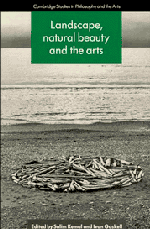Book contents
- Frontmatter
- Contents
- List of contributors
- Editors' acknowledgments
- 1 Nature, fine arts, and aesthetics
- 2 Natural beauty without metaphysics
- 3 Trivial and serious in aesthetic appreciation of nature
- 4 The public prospect and the private view: the politics of taste in eighteenth-century Britain
- 5 Landscape in the cinema: the rhythms of the world and the camera
- 6 The touch of landscape
- 7 Desert and ice: ambivalent aesthetics
- 8 Gardens, earthworks, and environmental art
- 9 Comparing natural and artistic beauty
- 10 Appreciating art and appreciating nature
- 11 The aesthetics of art and nature
- 12 On being moved by nature: between religion and natural history
- Index
9 - Comparing natural and artistic beauty
Published online by Cambridge University Press: 03 May 2011
- Frontmatter
- Contents
- List of contributors
- Editors' acknowledgments
- 1 Nature, fine arts, and aesthetics
- 2 Natural beauty without metaphysics
- 3 Trivial and serious in aesthetic appreciation of nature
- 4 The public prospect and the private view: the politics of taste in eighteenth-century Britain
- 5 Landscape in the cinema: the rhythms of the world and the camera
- 6 The touch of landscape
- 7 Desert and ice: ambivalent aesthetics
- 8 Gardens, earthworks, and environmental art
- 9 Comparing natural and artistic beauty
- 10 Appreciating art and appreciating nature
- 11 The aesthetics of art and nature
- 12 On being moved by nature: between religion and natural history
- Index
Summary
The title of this article might trigger in the memory of some readers a famous poetic couplet:
I think that I shall never see
A poem as lovely as a tree.
Is such a comparison legitimate? Is it even meaningful? Just for a moment let us pursue a negative answer to this latter question by imagining that Joyce Kilmer originally wrote the poem as a student in a creative writing course, and received the following criticism from his instructor:
Although it is sometimes a good idea to begin a poem with a paradoxical thought, yours is quite confused. Your first sentence wrongly assumes that a meaningful comparison can be made between trees and poems in respect of their loveliness. But a tree is beautiful because its organic form delights the eye, while a poem's beauty lies in its expression of human thought and feeling, which is something quite different. There is no way to compare them, and the rest of your poetic effort proves the point, because all you do is slurp on about the tree, without even a nod toward great poetry. Perhaps you should try a course in the School of Business.
This is not an entirely fictitious example. Formalist genre critics such as Cleanth Brooks and Robert Penn Warren actually dismissed the validity of the poem's opening couplet, remarking that “the two kinds of loveliness, that of art and that of nature, are not comparable.”
- Type
- Chapter
- Information
- Landscape, Natural Beauty and the Arts , pp. 183 - 198Publisher: Cambridge University PressPrint publication year: 1993
- 1
- Cited by



